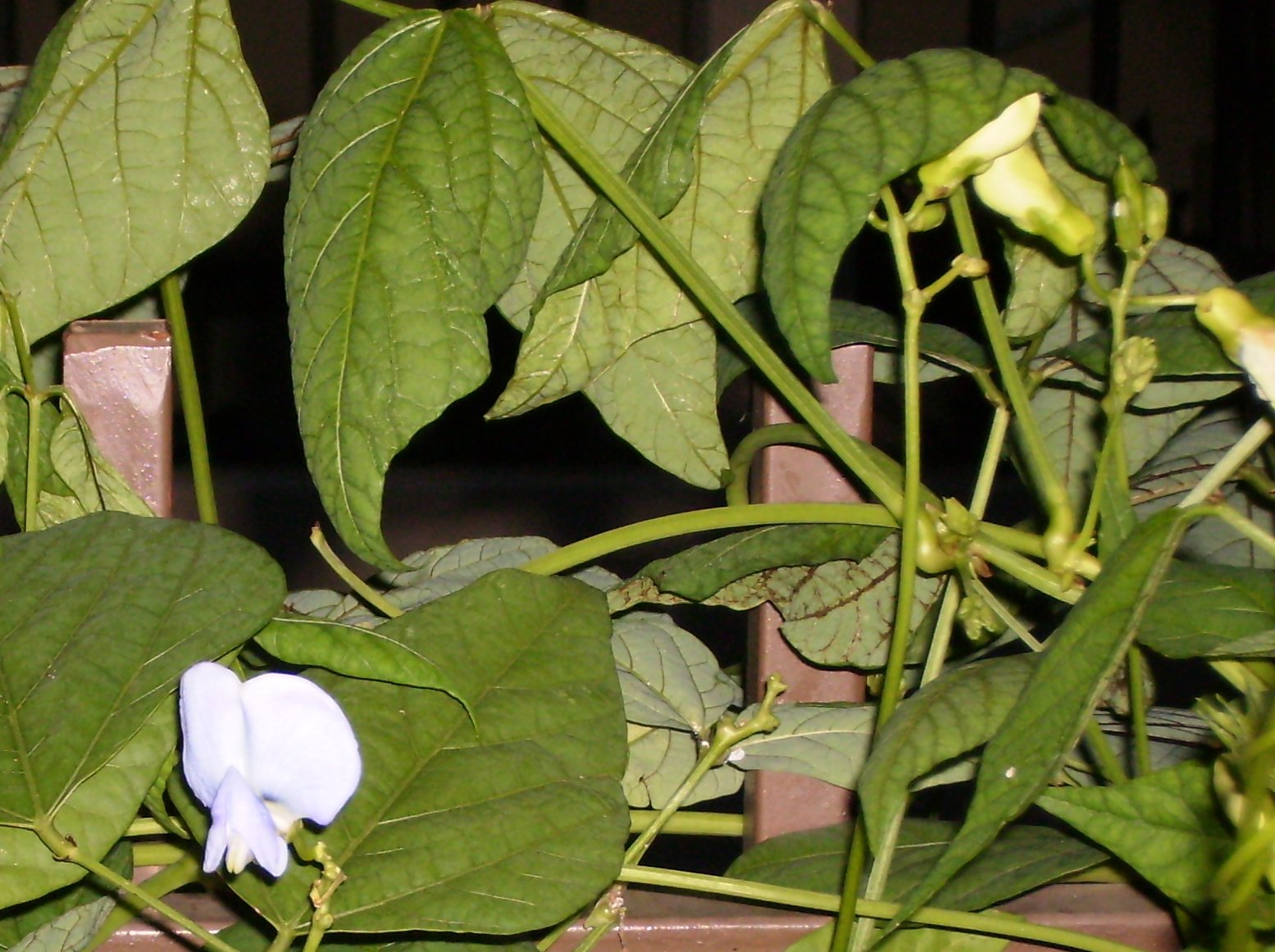- Winged bean
image_width = 250px
image_caption = Winged bean flowers and leaves
regnum =Plant ae
divisio = Magnoliophyta
classis = Magnoliopsida
ordo =Fabales
familia =Fabaceae
subfamilia =Faboideae
tribus =Phaseoleae
genus = "Psophocarpus "
species = "P. tetragonolobus"
binomial = "Psophocarpus tetragonolobus"
binomial_authority = (L.) D.C.The Winged bean ("Psophocarpus tetragonolobus"), also known as the Goa bean (kacang botol in Malaysia), is a tropical
legume plant native to PapuaNew Guinea . It grows abundantly in hot, humidequator ial countries, from thePhilippines andIndonesia toIndia ,Burma ,Thailand andSri Lanka . It does well in humid tropics with high rainfall.The winged bean plant grows as a vine with climbing stems and leaves, 3-4 m in height. It is an
herb aceous perennial, but can be grown as an annual. It is generally taller and notably larger than theCommon bean . The bean pod is typically 15-22 cm (6-9 in) long and has four wings with frilly edges running lengthwise. The skin is waxy and the flesh partially translucent in the young pods. When the pod is fully ripe, it turns an ash-brown color and splits open to release the seeds. The largeflower is a pale blue. The beans themselves are similar to soybeans in both use and nutritional content (being 29.8% to 39% protein).The plant is one of the best nitrogen fixers with nodulation accomplished by the
soil bacterium "Rhizobium ". Because of its ability to fixnitrogen from the atmosphere, the plant requires very little or nofertilizer s.Being a tropical plant, it is sensitive to frost. It will not flower if day length is more than 12 hours. The seeds have a hard coat and it helps to presoak the seeds before planting to hasten
germination . The plant grows very quickly, reaching a length of four meters in a few weeks.Uses
This bean has been called the "one species supermarket" because practically all of the plant is edible. The beans are used as a
vegetable , but the other parts (leaves, flowers, andtuber ous roots) are also edible. The tender pods, which are the most widely eaten part of the plant, can be harvested within two to three months of planting. The flowers are often used to colorrice and pastries. The flavor of the beans has a similarity toasparagus . The young leaves can be picked and prepared as aleaf vegetable , similar tospinach . The roots can be used as aroot vegetable , similar to thepotato , and have a nutty flavor; they are also much more rich inprotein than potatoes. The dried seeds can be useful as aflour and also to make acoffee -like drink. Each of these parts of the winged bean provide a source ofvitamin A ,vitamin C ,calcium ,iron , and othervitamin s. [Nutrition Facts for winged bean seeds, leaves, and tubers [http://www.healthaliciousness.com/nutritionfacts/nutrition-comparison.php?o=16135&t=11597&h=11599&s=100&e=100&r=100] ]It is possible that, with a little selective breeding, the winged bean could raise the standard of living for millions of people in poor, tropical countries.The Goa bean needs at least 12 hours light not less.=Synonyms=
* Goa bean
* Dambala (Sinhala )
* Kacang botol (Malay )
* Kecipir (Indonesian)
* Jaat (Sundanese)
* Sigarillas (Tagalog)
* sirahu avarai (Tamil)
* ถ้วพู Tua phoo (Thai)References
* Venketeswaran, S., M.A.D.L. Dias, and U.V. Weyers. "The winged bean: A potential protein crop". p. 445. In: J. Janick and J.E. Simon (eds.), "Advances in new crops". Timber Press, Portland, OR (1990).
* [http://www.leafforlife.org/PAGES/PSOPHOCA.HTM Entry for the Winged Bean in the "Leaf for Life" website]
* Verdcourt, B. and Halliday, P. A revision of "Psophocarpus" (Leguminosae-Papilionoideae-Phaseoleae). "Kew Bulletin", 1978; 33: 191-227.
* Kadam, S.S., Lawande, K.M., Naikare, S.M. and Salunkhe, D.K. Nutritional aspects of winged bean ("Psophocarpus tetragonolobus" L.DC). "Legume Research", 1981; 4(1): 33-42.
* Smartt, J. Gene pools in grain legumes. "Economic Botany", 1984; 38(1): 24-35.
* Hettiarachchy, N.S. and Sri Kantha, S. Nutritive value of winged bean, "Psophocarpus tetragonolobus". "Nutrisyon" (Philippines), 1982; 7: 40-51.
* Sri Kantha, S. and Erdman, J.W.Jr. Winged bean as an oil and protein source; a review. "Journal of American Oil Chemists Society", 1984; 61: 215-225.
* Sri Kantha, S. and Erdman, J.W.Jr. Is winged bean really a flop? "Ecology of Food and Nutrition", 1986; 18: 339-341.
* Dr. James A. Duke's letter: [http://www.townsendletter.com/AugSept2007/foodfarmacy0807.htm]
Wikimedia Foundation. 2010.

